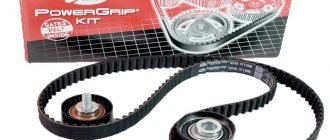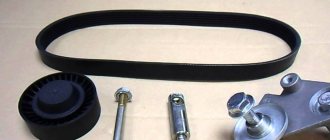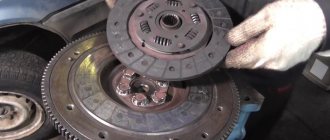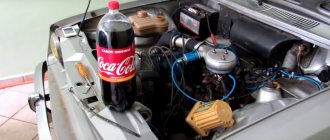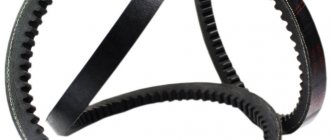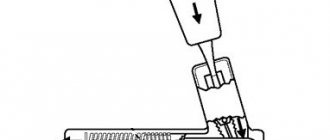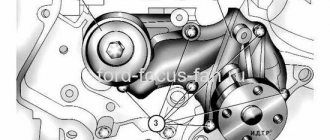Signs and symptoms
There are six main signs that the timing belt has jumped.
- The car engine is unstable.
- The engine constantly stalls.
- Noticeable loss of engine power and thrust.
- The engine starts with problems or does not start at all.
- The power plant is stuck.
- The sound of the engine becomes louder - a metallic knock appears.
Most often, it happens that the product jumps one tooth, and because of this, the engine continues to operate, but increases fuel consumption, and there are also interruptions in operation and starting.
If you suspect that several teeth have jumped, you should not restart the engine. In the worst case, this can cause the valves to bend.
Causes
The timing belt is an important element of the car, so it needs to be serviced promptly. The reasons that lead to its jump are as follows:
Contact of oil or cooling liquid on the belt surface
As soon as traces of technical fluid appear on the product, the belt should be changed immediately. Otherwise, this can lead to slipping through the teeth, sliding off the pulley, and even breaking.
It is a serious mistake when drivers simply clean the dirty surface and continue to use this product.
Practice shows that if liquid gets on the belt, it is completely absorbed into the rubber. It loses its properties and begins to stretch.
Late replacement
Most timing belt manufacturers recommend changing their products approximately every 60 thousand kilometers. However, this figure may vary up or down, depending on the quality of the product.
Improper use
It happens that a product may jump due to errors during its operation. A common example is a weakened roller or tensioner. When the belt tension weakens, there is a possibility of slipping from the pulley grooves. In the opposite situation, if when installing the belt, it is overtightened, this will lead to its breakage.
Slippage can also occur when one of the pulleys has strong play. Therefore, it is very important to monitor the tension level of all parts of the mechanism.
The labels are set incorrectly
Sometimes the jump is not visible outwardly, but the engine does not start well and immediately stalls. This can happen if the marks were knocked down or incorrectly set initially. A shift of even one tooth can cause problems with the motor. If the engine is diesel, it will not start even if there is an error of one tooth.
It is necessary to replace the timing belt in safe places using special tools.
This photo shows that the intake is offset by one tooth clockwise; this is one of the most common mistakes when replacing a belt. To prevent this from happening, you can use special pulley clamps when replacing the timing belt.
External damage
Over time, various cracks and depressions may appear on the surface of the consumable, and the threads of the product may begin to peel off. With heavy loads on the belt, even the smallest defects will develop quite quickly. Therefore, they cannot be eliminated on your own. All you can do is replace it as soon as possible.
Low quality spare parts
There are very cheap “non-original” belts on sale. But don't be fooled by their price. Often the resource of such a product is only enough for 20 thousand kilometers. This is followed by either stretching or breaking.
Difficult operating conditions
Unlike a chain, a belt is very sensitive to high and low temperatures, high humidity and other weather conditions. They affect premature wear of the product. Therefore, more frequent replacement may be required.
What is the timing belt used for and where is it located?
The main task of the part is to transmit torque from the camshaft to the crankshaft, as well as ensure their synchronous rotation. This synchronization is very important for the proper operation of the gas distribution mechanism, which injects the fuel-air mixture into the cylinders and subsequently releases the exhaust gases.
The serviceability of the belt is also very important for engines in which the pistons are located in the same block with the valves. This type of scheme is now the most common. However, despite the fact that the valves are located in the same space as the pistons, these components are not found precisely because of the timing belt. In the event of a break, the piston hits the open valve and it bends, plus the piston jams. As a result, the engine requires serious repairs. In particular, cylinder heads.
Timing belt with a set of fasteners and rollers
For each car, manufacturers indicate in the instructions their mileage, after which the timing belt must be replaced. For foreign cars, the mileage before replacement can be up to 120 thousand km. Domestic cars have 50–60 thousand km. But it’s still better to play it safe, subtract about 15% from the recommended values and use the mileage obtained as a guide. If the time of the last replacement is not known, it must be carefully inspected for wear.
Consequences of a broken timing belt
Finding the part will not take much time. After the hood is raised, the toothed belt made of durable, dense rubber almost immediately catches your eye. Unlike its other brothers, it can pass through a number of other pulleys. So, along with transmitting torque from the crankshaft to the camshaft, the part can also perform a number of additional functions. All of the above causes constant high loads, leading to gradual wear, even despite the strength of the materials from which it is made.
Why might it break?
It happens that even a new belt wears out and breaks in a very short time. Most likely, a displacement occurs, due to which the belt “eats” and subsequently breaks. There may be several main reasons:
- In the vast majority of cases, the fault lies with the pump, since the bearings in it are not in the center of the pulley, but are slightly shifted to the side. Their wear over time can lead to warping of the pump axis, which means warping of the pulley and slipping of the timing belt. It also happens that when installing a new pump, the mounting area was poorly cleaned and even small residues of dirt or grease can lead to a distortion that is invisible at first glance, but significant in the future.
- Severe wear on the tension or guide rollers.
- A leak of engine oil has appeared from the camshaft oil seal.
- Worn teeth on the camshaft and crankshaft gears. A characteristic sign in this case is the appearance of peeling teeth on the belt itself.
- The mechanism is either too tight or too loose.
Consequences
The consequences of the timing belt jumping several teeth can be different - from replacing the timing belt itself to repairing the car’s gas distribution mechanism.
The amount of damage depends on whether the engine has recesses for valves in the pistons or not.
A jump can occur while the valves are being lowered to inject fuel or release gases. The pistons are still moving and can hit the valves hard. This will lead to bending of the latter. This situation is similar to a broken timing belt. You can read more about which engines this happens on in this article.
To avoid this situation, it is recommended to do a timely inspection and, if necessary, change the consumable.
Repair cost
The average price for replacing a belt and roller in car services ranges from one to three thousand rubles. The price range is due to the fact that replacing parts on foreign cars costs approximately 2–3 times more than on domestic cars.
If it turns out that you also need to change the engine water cooling pump and the crankshaft oil seal, then the price will increase by another 1 - 1.5 thousand rubles.
Although there is a huge selection of products on the market at different price levels, you should only choose brands recommended by the manufacturer or their high-quality analogues. Using cheap parts can lead to serious damage and expensive repairs.
For example, if the valves are bent as a result of a belt slipping, then almost the entire cylinder head will have to be replaced. Even if the repair is carried out by yourself, the cost of replacing valves, pump, belt, filling oil and antifreeze, and other parts will be at least 10,000 rubles.
Source: grmexpert.ru
The main 9 reasons why the timing belt eats
There are a huge number of reasons for belt slipping and wear, but there are also the main culprits of this problem, which are described below.
Poor quality belt
As you know, there are quite a lot of fakes for domestically produced cars, and it is very easy to run into a clandestinely manufactured timing belt. A fake belt may have an irregular shape, namely an oval center, or, on the contrary, any of the edges may be uneven, similar to a cone, which will lead to inevitable distortion of the belt and soon it will slide in different directions. Such problems occur due to incorrect or broken belt production technology.
Belt tension
Incorrect belt tension contributes to the rapid eating of the belt or its breakage, which can lead to dire consequences and expensive repairs of the internal combustion engine. It is necessary to tension the belt correctly, following the manufacturer's recommendations.
Roller bolt and stud
A stud and bolt are necessary to secure the timing belt tensioner and idler pulley. When they are skewed, the alignment of the mechanism elements is disrupted, as a result of which the belt begins to walk along the pulleys, which leads to its rapid wear.
Thread
The threads in the cylinder head or the block itself may be damaged, which will lead to inevitable misalignment of the pin or bolt securing the rollers. And as described above, the misalignment of this pin threatens to warp the belt and cause it to slide towards the misalignment.
water pump
The pump has a bearing in its design, which is subject to aging and over time can slightly tilt the water pump pulley, which will lead to the belt slipping and being eaten.
Incorrectly installed pump
When replacing the pump, it is possible that some of its mounting bolts will be looser, which, under the influence of belt tension, can lead to its distortion.
Roller wear
Timing rollers in new modifications of VAZ cars are made of plastic. This plastic, although super strong, is still susceptible to wear and over time can wear into a cone shape, which can cause the timing belt to slip.
Camshaft gear wear
With a mileage reaching 150 thousand km, wear on the camshaft gears is common. This problem occurs quite often after reaching this mileage.
Crankshaft gear wear
The most likely problem with a timing belt eating is the crankshaft gear. Under the influence of various dirt and sand, which gets under the belt and wears out the gear, which will inevitably lead to misalignment, eating and wear of the belt.
How to understand that it is time to urgently change the timing belt
On most modern engines, the scenario for a motor accident is as follows. When the timing belt breaks, the camshaft stops rotating and the valves stop in one position. Meanwhile, the crankshaft continues to rotate by inertia, and the pistons “meet” the valves. The camshaft elements, cylinder head, connecting rod group, pistons and more can also become deformed or destroyed. As you understand, repairing the power unit after such a scenario will cost a pretty penny.
The service life of the timing belt, depending on the model, varies from 50 to 100 thousand km (the exact data is indicated in the car’s service book), but you cannot rely on these figures in all cases. It happens, for example, that a car has low mileage, but the belt itself is more than five years old. By this time, this part will almost certainly be worn out due to the natural aging of rubber.
No less often, the service life of the belt is affected by its incorrect installation and external influences. Let's say, a fairly common reason for the premature death of a belt is dirt or debris from previously broken generator and air conditioning compressor belts getting under it, but even more often - oil spillage from leaking camshaft seals, as well as coolant from a leaking pump.
Human factor
ATTENTION! A completely simple way to reduce fuel consumption has been found! Don't believe me? An auto mechanic with 15 years of experience also didn’t believe it until he tried it. And now he saves 35,000 rubles a year on gasoline! Read more". As you know, the average service life of a timing rubber ring is 50-60 thousand
kilometers of vehicle mileage. But this is only passport, unreal data. In fact, it is rare for any belt, even the highest quality, to “plow” so much. And the belt often suffers from factor number one - illiterate human actions
As you know, the average service life of a rubber timing ring is 50-60 thousand vehicle kilometers. But this is only passport, unreal data. In fact, it is rare for any belt, even the highest quality, to “plow” so much. And the belt often suffers from factor number one - illiterate human actions.
The fact is that the strength of the rubber ring threads is not infinite. With a strong tension, and this is natural, a timing belt break is not far off. By the way, the same result awaits the belt if it is stored incorrectly.
And a loose belt, or rather, not tightened enough, is a sea of problems, absolutely everyone agrees with this. Such a ring will not last long, because vibrations will lead to uneven impact on different parts of the belt. Eventually it will break.
The negligent attitude of a person, in this case the car owner, has an extremely negative impact on the service life of any part of the car, including the belt. For example, if you don’t take enough care of the rubber ring cover of the GDS mechanism, the level of protection will gradually be reduced to nothing. This means that any pebble that gets on the rotating belt will tear it completely.
In general, negligence or absent-mindedness is dangerous everywhere, in any sphere of human activity. There is also an article of the criminal code that punishes this. Here, too, I want to not only warn careless owners, but take tough measures for their own good. Well, for example, how can you forget about NTZh and NPR rollers, because they work in tandem with the belt and have a direct impact on it?!
A great many difficulties can be caused by various malfunctions of flywheels, for example, their flanges. Often, during the process of dismantling with your own hands, the owner does not act carefully, damaging the flanges. And after this, the latter function extremely dangerously for the belt, as they easily cut the edges of the rubber ring. An incorrectly installed belt guard can have the same result.
It is also not uncommon that, if assembled incorrectly, the shaft wheels may end up in different planes. What this leads to is probably not worth writing about.
The camshaft locking also has a negative effect on the belt, but this is a rare case. This usually happens due to insufficient lubricant levels. As a result, the forces in the drive increase and several teeth break off at once.
People often ask on forums whether it is possible to use a relatively new belt after repairing an internal combustion engine? Reuse is certainly possible, but the ring must be installed in the same way as before dismantling.
“Are there valves? What if I bend it?” How to change the timing belt correctly
For example, we took a fairly simple Renault Logan engine, Renault K7M. Why this one? Firstly, it is eight-valve, and secondly, replacing the belt on this engine will give a fairly objective picture that can be safely projected onto any eight-valve engine. We won’t consider 16-valve units for now, God forbid we can do something decent with this engine.
What do we need?
Our task is to complete the work in conditions as close as possible to “garage” conditions, without using rare tools or equipment that the average car enthusiast does not have. I asked specialist Nikita Pisarenkov to help complete the work, comment on its implementation and warn against possible mistakes. But before you go to the service center, let’s collect everything you need for the upcoming work.
Of course we need a new timing belt. Owners of cars whose camshafts turn chains now grin disdainfully: “Ugh, belt! Either change it, or buy a defective one. It’s just a chain!” Laugh, laugh, gentlemen. “Chain VS Belt” debate could have started back in Ancient Greece, if cars existed then. Wrapped in sheets, very ancient Greeks would splash drool in the faces of their opponents and give dozens of arguments in favor of the views they defend.
But now it is no longer so important to us which gas distribution mechanism drive is better. If there is a belt, it needs to be changed (although I note that sometimes the chain also needs to be changed, and sometimes even more often than we would like). What are the dangers of not caring about the timing belt? At best, it will simply break and the car will stall.
At worst, a torn belt will cause trouble in the cylinder head: the valve timing will be disrupted, and the valves will suddenly remain open at the very moment when the piston rises to top dead center. What next? That's right, the valves will bend and lose the ability to move in their guides, ensuring gas exchange in the engine.
A long time ago, when the Mercedes-Benz W140 and the dollar cost not even 30 rubles, but only 6, engines with grooves in the pistons were in use. When the valves “met” with them, they remained inside the grooves intact and unharmed. But here’s the problem: the grooves had a bad effect on the combustion efficiency of the gasoline-air mixture, and you won’t see any “insurance” on modern engines. These, the motors of recent decades, are rightly called “plug-in” by masters.
From the point of view of philology, the word is dubious, but in fact everything is so - “sticking” is popularly called the very meeting of pistons and valves, leading to the bending of the latter. Repairing the motor in this case can be expensive or even very expensive. In general, you already understand whether you want it or not, but the belt needs to be changed. Different manufacturers indicate slightly different service life, but on average this spare part lasts 50-70 thousand kilometers.
In order for the belt to perform its function - transmit rotation from the crankshaft to the camshaft properly, it must be properly tensioned. The tension is provided by a special roller, which is quite expectedly called a tension roller. By design, this is a regular roller, but with a shifted center of rotation, so that it can be moved relative to the axis of rotation. The tension roller should be changed at the same time as the belt. You shouldn’t trust its imaginary durability; over time, the lubricant in it ages, it begins to heat up more and more, and this disgrace leads to its jamming.
For the belt, this is like death, and then everything follows the above plan: breakage - bending of the valves. Therefore, it is better not to skimp and change the roller every time you replace the belt; it is not so expensive, but you can be calm about the timing drive. By the way, it is not necessary to buy the original video; here this concept is very relative. Somewhere from the factory there are rollers from Koyo, SKF or some other products from very decent manufacturers. The dealer will be happy to sell a kit from the same company, but with his own markup.
But lately dealers have been gradually reducing their appetites. For example, a set of SKF roller and belt for our experimental Logan cost 1,790 rubles in a regular store, but we bought it from an official dealer for 1,901 rubles. The overpayment, as we see, is small, but it gives peace of mind. Well, at least it should be calmer.
Signs of a Dying Belt
Visual
It is believed that a visual inspection will help determine the life of the drive. Fraying, tears, cracks, etc. They can tell you whether the belt will still “run” or break after a few kilometers.
Let's figure it out right away. The belt can not only break. The teeth on it wear out. This is fraught with its “slip” on the camshaft. The valve timing will go wrong, the engine will not only lose its power, but will also have difficulty working. In some cases, pistons and valves may meet. The result of their “union” will be a major overhaul.
So, a visual inspection may not show wear or broken teeth. Some of them may be hidden far from your eyes. Others at this moment will be on the shaft sprockets. Everything looks good, but in reality they are already on the verge of a bummer.
Secondly, not all engines have timing belts within visual reach. Some are hidden by protective covers, which are under the front plate of the motor. Partial disassembly is required to get to them. On most BMW engines, it is necessary to “lower” the power unit in order to reach the timing belt. Having reached it, is there any point in inspecting it? – Since you are already there, it is better to replace it immediately, so as not to deal with nonsense for another 60-100 thousand km.
For example, the Opel Cadet engine belts can be easily seen by opening the hood of the car. But there are very few such models, so one can be skeptical about this sign of timing drive wear.
Best before date
Sorry, what is this, food? There is an opinion that there is an expiration date on the timing belt. Compliance with it guarantees reliable operation for this period only.
Each car manufacturer has regulations for replacing the gas distribution mechanism drive. Only strict adherence to it can give any guarantee, and even then it is not one hundred percent.
This also includes the myth about the inverse relationship between engine power and belt service life. V-shaped monsters with a volume of more than 4 liters can live with their “native” strap for hundreds of thousands of kilometers. And vice versa, low-volume engines, for example VAG engines, do not always live up to 100 thousand km.
Many people recommend changing the belt after 5-6 years of using the car. But if during this period the car has driven 200 thousand, then of course. If the mileage has barely exceeded 30,000, and the car is 7 years old, then why do a replacement operation that is not always cheap if it still “uses” enough time?
Many may argue that this is a rubber product, which dries out over time and loses its mechanical properties. Yes, but if external factors, aggressive liquids, dust, dirt, reagents do not have any negative impact on it, then why should it deteriorate? – This is another myth.
Unlike the cooling system hose, brake and fuel hoses, and suspension silent blocks, which face destructive factors, the timing belt does not experience this. Only in exceptional cases can it begin to “age” faster, but we’ll talk about this below.
Extraneous sounds
This is another sign of an imminent belt break. I am ready to agree with this. From my experience, I note that in 80% of cases, shuffling, cyclic sounds will be a direct sign indicating the need for replacement.
But tensioner rollers and sprockets can make noise. Incorrect operation of attachments, such as a pump, can be echoed. In this case, it is necessary to “open” the front plate or more detailed diagnostics in order to identify the source of the unpleasant noise.
Oil
This is a 100% sign that the timing belt needs to be changed. As mentioned above, the encounter of rubber products with aggressive media, such as oil, leads to a rapid loss of their mechanical properties.
Again, it is not always possible to visually diagnose this. Yes, if there are oil streaks on the front plate in the pulley area, not fogging, then the chance of an oiled belt increases. A leaking crankshaft oil seal will result in oil getting onto the belt.
In cases of Opel Cadet, where the belt is not covered with anything, it can suffer not only from oil deposits, but also from antifreeze, for example. Here we turn to the first sign - a visual examination does wonders for diagnosis.
Used car
This is not just a sign, but a primary necessity. After buying a used car, the first thing you need to do is go to a service center and change the timing belt. Troubleshoot the tensioner, shoes, sprockets, damper, if any, for wear. Often, previous owners did not bother preparing the car for sale. Why change something if you are going to “throw away” your old car.
Extending the life of the alternator belt
So, in order for the alternator belt to last a long time, you need to take care of it. Carefully check for debris and dirt in the belt tracks. Check the tension of the alternator belt promptly and carefully. A properly tensioned alternator belt should rotate 90 degrees. A too-tightened alternator belt will quickly become unusable and lead to a series of breakdowns. The consequences of a tightened belt can be sad. This is mainly the failure of the bearings of the generator, pump, air conditioning clutch and power steering. If the alternator belt is not tightened, the belt may squeak when the headlights or air conditioning are turned on, that is, when a load appears on the belt, it will slip along the pulley, which will quickly render it unusable. It is advisable to buy belts from trusted manufacturers and only ones suitable for a car of a specific brand. It is not recommended to install used belts.
Reasons why the alternator belt breaks
There are a huge number of reasons why the alternator belt breaks. It is not always possible to predict a broken alternator belt. Therefore, you should carefully monitor the technical condition of the car.
Aging
The main reason for a broken alternator belt is aging. During its service life, the belt experiences enormous loads, from mechanical to thermal. Over time, the elasticity of the belt is lost; it becomes rougher and more fragile; cracks appear, resulting in breakage.
Seized bearings
Another very common problem with a broken generator belt is jamming of the bearings of the mechanisms that drive the generator belt. For example, such as a generator, pump, air conditioning compressor, power steering, etc. To prevent the belt from breaking for this reason, you should listen to the operation of the engine and, if noise appears, eliminate the cause of the noise.
Foreign objects getting under the belt
While driving on the roads, you can often notice various debris or something similar on the road. All this can cause the generator belt to break. Quite often there are cases when stones or sticks get under the generator belt, as a result of which the belt experiences overvoltage and breaks. The same can happen if the car is driven through deep snow, water or mud. In order to avoid such a set of circumstances, it is not recommended to drive without protective boots and generator casings.
Timing belt selection
The belt in the gas distribution mechanism plays a very important role; during the work process it is constantly subjected to dynamic loads. For this reason, special attention is paid to the quality of this component. To purchase a durable and reliable belt, you should pay attention to the manufacturer. Among the most important brands that you should give preference to are the following:
- Contitech;
- Gates;
- Dayco;
- Bosch.
You need to purchase belts only from trusted suppliers, this will help protect against counterfeits.
After completing the work related to replacing the timing belt, you need to start the engine and listen to how it works. If the device is tensioned well, no extraneous sounds will appear, but if the belt is slightly overtightened, you can hear the hum or whistle of the tension roller. In this case, the belt will have to be loosened a little by turning it counterclockwise. If you carry out the replacement work competently and carefully enough, you will not have to face the question of how often to change the timing belt.
What to do when the alternator belt breaks on the road
The first thing you should do is not panic, because there is a way out of any situation. If you are in the city or not far from an auto parts store. You can get to the store without an alternator belt, but you first need to assess the situation.
Some vehicles use an alternator belt drive to rotate the coolant circulation pump. Therefore, if on your car the coolant circulation pump is driven by the alternator belt drive, then driving without an alternator belt on such a car is strictly PROHIBITED . If you start driving such a car, the engine will inevitably overheat and fail.
If the pump on the car is rotated by the timing belt drive, then you can safely continue driving on the battery. For a longer trip, you must turn off all electrical equipment of the car, i.e. turn off the headlights (if you are driving at night, you can turn off one right headlight and continue driving with one headlight, this will save battery power), the interior heater, music, etc. On a well-charged battery, you can travel up to 50 km.
